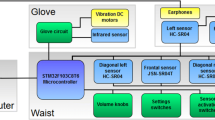Abstract
Most blind and vision-impaired people use a white cane or a guide dog to aid their walking. The conventional white cane helps the user to perceive the environment simply by identifying the presence of nearby obstacles. In the present study, three infrared range sensors were used to identify the floor state. The sensor system, affixed to the user’s belt, does not require swinging motion or any other movement by the user. The three sensors are configured radially, and the design parameters are selected based on the sensor characteristics. The main difference from the conventional range sensor system for the blind is that the infrared range sensor system identifies three discrete states (even surface, ascending stair, descending stair). The condition for the state transition was derived from a sensor system model. Additionally, the effects of sensor system movement were verified by covariance analysis.
Similar content being viewed by others
References
D. Yuan and R. Manduchi, A Tool for Range Sensing and Environment Discovery for the Blind, 2004 Conference on Computer Vision and Pattern Recognition Workshop (CVPRW’04), 3 (2004) 39.
D. Yuan and R. Manduchi, Dynamic Environment Exploration Using a Virtual White Cane, Proceedings of the 2005 IEEE Computer Society Conference on Computer Vision and Pattern Recognition (CVPR’05), 1 (2005) 243–249.
M. D. Adams, On-Line Gradient Based Surface Discontinuity Detection for Outdoor Scanning Range Sensors, Proceedings of 2001 IEEE/RSJ International Conference on Intelligent Robots and Systems (2001) 1726–1731.
A.-C. Scherlen, J. C. Dumas, B. Guedj and A. Vignot, Recognize Cane, The new concept of a cane which recognizes the most common objects and safety clues, The 29th Annual International Conference of the IEEE Engineering in Medicine and Biology Society (2007) 6356–6359.
The Miniguide ultrasonic mobility aid, http://www.gdpresearch.com.au/ultra.htm.
J. M. Benjamin, N. A. Ali and A. F. Schepsis, A laser cane for the blind, Proceedings of San Diego Biomedical Symposium, 12 (1973) 53–57.
D. Bissitt and A. D. Heyes, An Application of Biofeedback in the Rehabilitation of the Blind, Applied Ergonomics, 11 (1980) 31–33.
H. Kim, M. Lee, S. Park and S. Lee, Exploration of Floor Surface for the Blind, The 6th International Conference on Ubiquitous Robots and Ambient Intelligence (URAI 2009), (2009) 575–579.
L. Kim, S. Park, S. Lee and S. Ha, An electronic traveler aid for the blind using multiple range sensors, IEICE Electronics Express (6) 11, (2009) 794–799.
Device Specifications for GP2Y0A710K, Reference manual, Spec. No. ED-06G062, August 24, 2006, SHARP Corporation.
Author information
Authors and Affiliations
Corresponding author
Additional information
This paper was recommended for publication in revised form by Associate Editor Yang Shi
Minyoung Lee received his B.S. degree in Mechanical and System Design Engineering from Hongik University, Seoul, Korea, in 2010. He is working towards his M.S. degree there. His research focuses on sensor fusion.
Sooyong Lee received his B.S. and M.S. degrees in Mechanical Engineering from Seoul National University, Seoul, Korea, in 1989 and 1991, respectively, and his Ph.D. degree from MIT, Cambridge, MA, in 1996. He worked as a Senior Research Scientist at KIST and then as an Assistant Professor in the Department of Mechanical Engineering at Texas A&M University. He joined Hongik University, Seoul, Korea, in 2003, and is currently an Associate Professor in the Mechanical and System Design Engineering Department. His current research includes localization and sensor fusion.
Rights and permissions
About this article
Cite this article
Lee, M., Lee, S. Design and analysis of an infrared range sensor system for floor-state estimation. J Mech Sci Technol 25, 1043–1050 (2011). https://doi.org/10.1007/s12206-011-0141-5
Received:
Revised:
Accepted:
Published:
Issue Date:
DOI: https://doi.org/10.1007/s12206-011-0141-5




